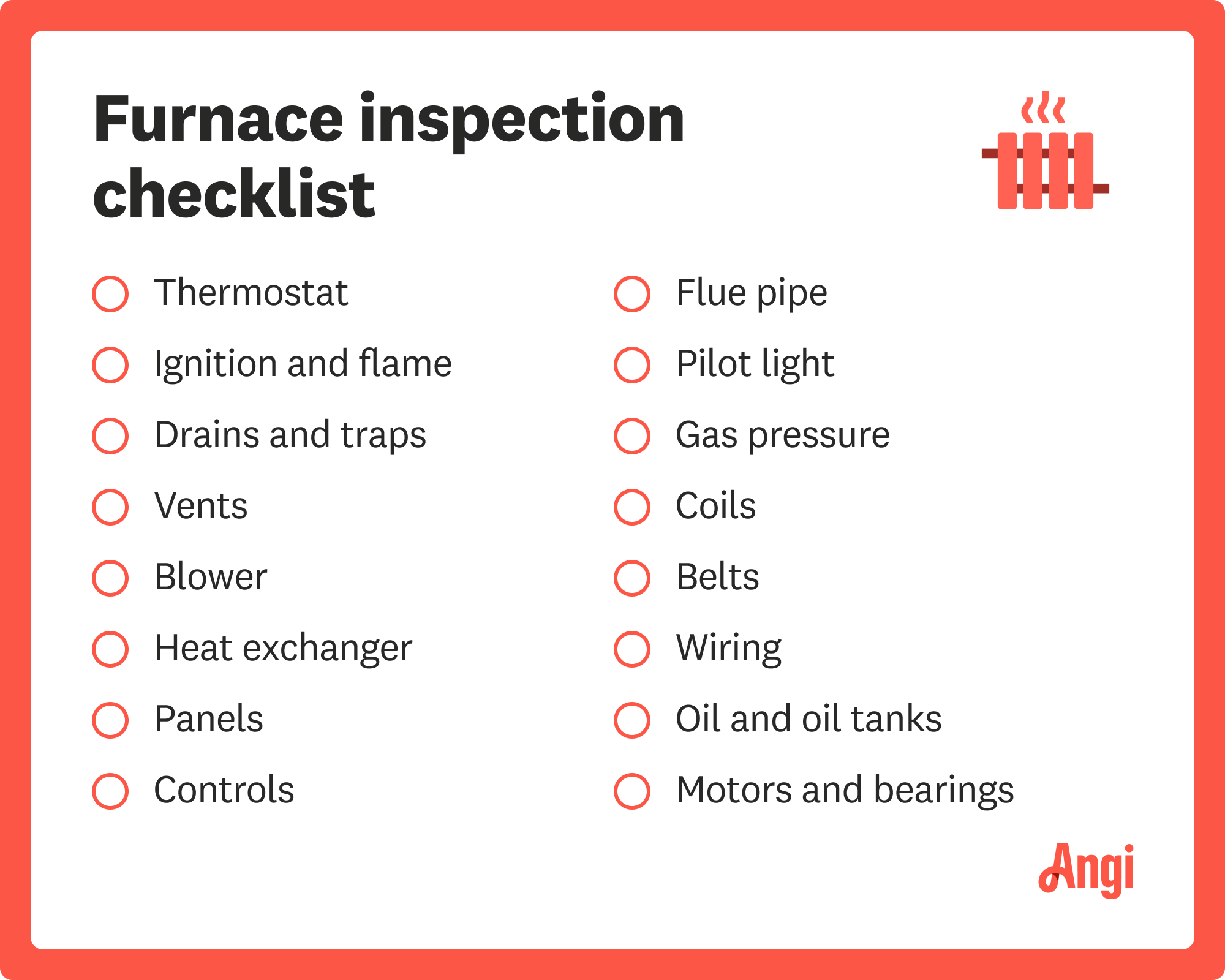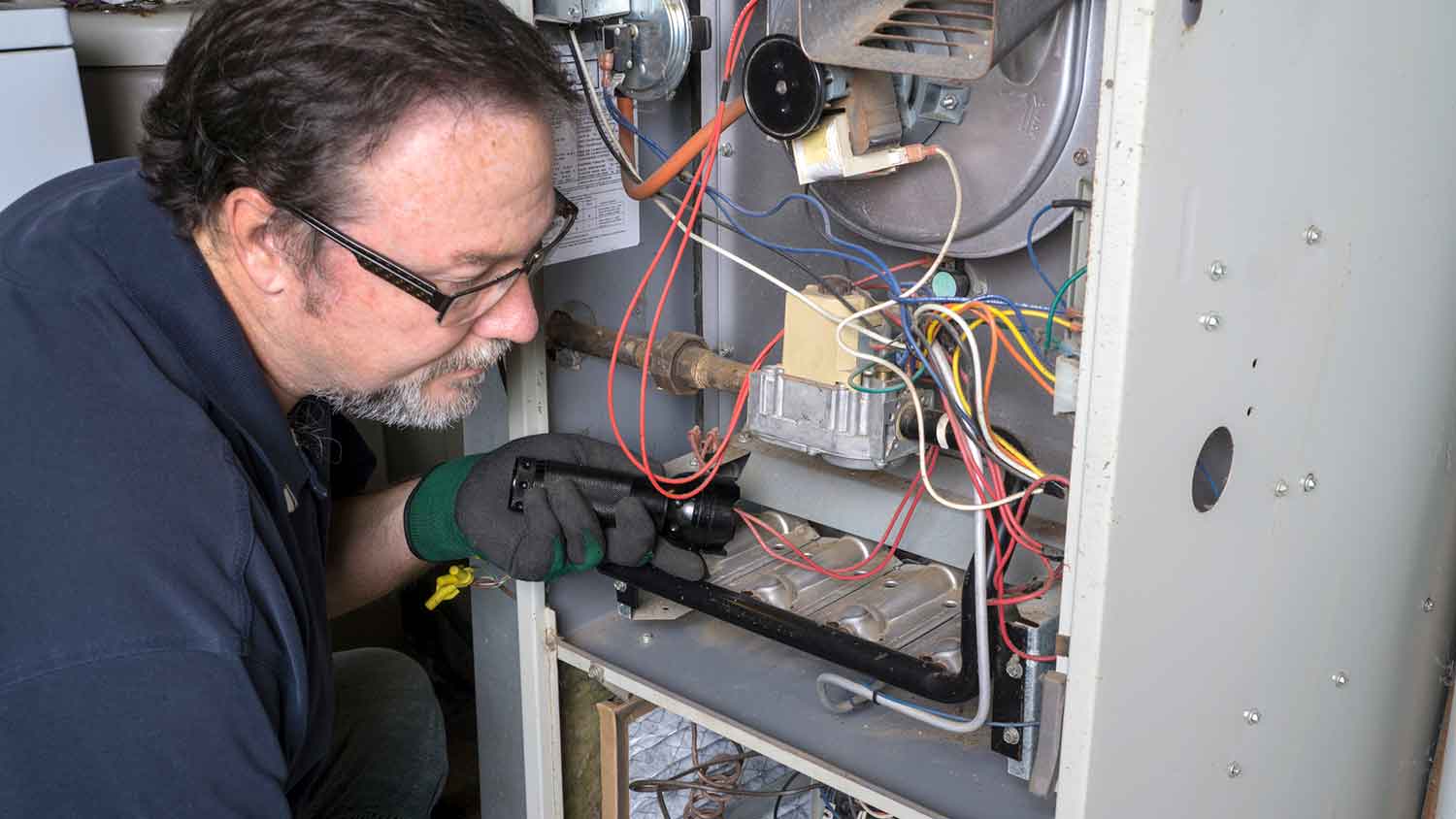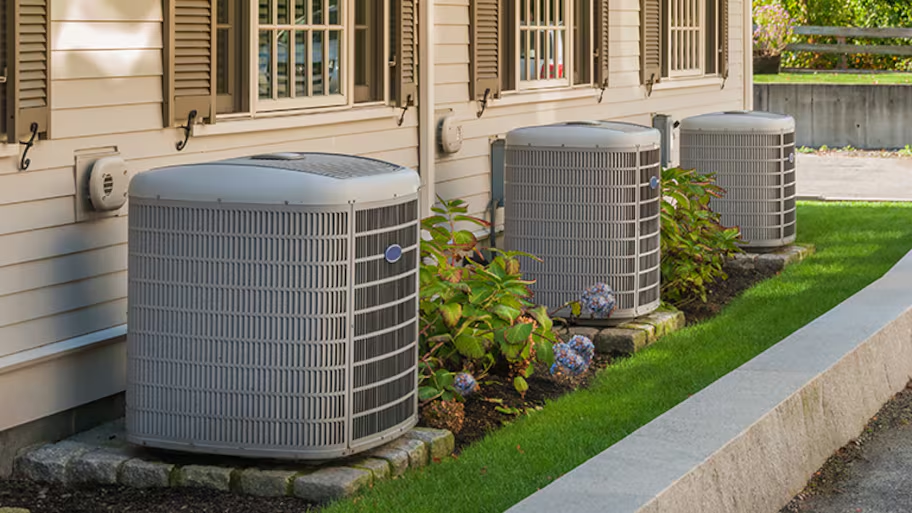
Explore how much an AC compressor costs to install based on cost factors like it’s type, brand, size, and local labor rates.
Heating and air conditioning service costs depend on your project and location. Check with a local pro for your specific job.
Gas and oil furnace inspections are slightly more expensive than electric.
You should inspect your furnace once a year to keep repair costs in check.
If properly maintained, a furnace should last up to 20 years.
A tuneup costs between $130 and $200 on top of the inspection cost.
Booking at the end of summer may unlock discounts on inspections.
A furnace inspection costs $100 on average, but prices can range from $50 on the low end to $300 or more. You can save on the cost of furnace inspections by scheduling in the off-season or if you’re heating a smaller home, while bigger furnaces and oil furnaces in particular cost more to inspect. You should be scheduling a furnace inspection at least once a year, typically ahead of winter, to catch and repair any issues before the cold weather sets in and a working heating system is a must.
From the type of furnace to the size of your home, several different cost factors influence what you’ll pay for a furnace inspection. In general, you can expect to spend about $80 to $100 for this service, and you’ll want to budget to pay for an inspection every year. Luckily, these small costs can add up to big savings, since HVAC professionals will be able to catch any potential problems before they get worse and warrant expensive repairs.

| Type | Average Cost |
|---|---|
| Electric | $70–$150 |
| Gas | $80–$175 |
| Oil | $100–$200 |
The cost to inspect a furnace ranges from around $50 to about $200. Inspections for gas and oil furnaces typically cost more than electric furnace inspections, because these types of furnaces have additional components to inspect. For example, an HVAC professional will need to check for any carbon monoxide leaks, which can lead to headaches, chest pain, eye and throat irritation, fatigue, shortness of breath or unconsciousness. Longer exposures may also cause brain damage and can be fatal.
The bigger the home, the more the furnace inspection will be. That’s because a larger home requires a larger HVAC system, and a professional will have more parts to inspect. According to U.S. Census data, the median home size is about 2,300 square feet. For homes bigger than the median, you’re likely to pay $100 or more for the cost of a furnace inspection. Smaller homes will be at the lower end of the cost spectrum.
Most people schedule their furnace inspections in the fall or early winter when the weather begins to turn, so demand can be high around this time of year. And if you try to schedule an inspection in the middle of winter when temperatures drop dramatically, you’ll likely see higher rates, as HVAC pros tend to be especially busy with emergency services. You’ll spend on the lower end of the average range, around $50 to $100, by scheduling a furnace inspection from spring to late summer.
If it’s been a few years since you’ve hired someone to inspect your furnace, you can expect a bigger bill this time around. The furnace will likely need a tune-up, which will cost about $130 to $200, in addition to a thorough inspection.
For a furnace inspection, you’re paying entirely for the labor and expertise of a pro, rather than spending money on parts and materials. Although HVAC contractors will typically charge a project rate for a furnace inspection, you could pay by the hour. HVAC contractors charge about $50 to $150 per hour, with an inspection taking about one hour or up to two hours for an advanced inspection that includes a tune-up.

Typically, when you schedule a furnace inspection, you’ll also need to budget for some standard maintenance tasks or minor repairs as well. However, these additional costs can save you money in the long term by minimizing the need for emergency repair services down the road.
A basic furnace inspection costs about $80 to $100 on average, but you can get additional services, like light cleaning and a tune-up, for the cost of an advanced furnace inspection—about $125 to $200. Outside of professional inspection and maintenance services, you should also install a new furnace filter about every 90 days. New filters cost about $1 to $35 apiece.
Furnace repairs cost about $130 to $500, depending on the type of damage. Inspections can catch minor issues that cost less to repair compared to bigger problems or a furnace breakdown that requires emergency repairs. You should schedule regular furnace inspections even if you don’t suspect anything is wrong, but be prepared to pay for any necessary repairs if there is an issue. Otherwise, you could risk going without a furnace for a day or two in the middle of winter if it breaks down when you need it most.
If your furnace breaks outside of typical hours, you’ll pay about $150 to $215 per hour for emergency services, in addition to the standard cost of furnace repairs. Ideally, you can avoid these costly emergency repairs by keeping up with annual furnace inspections.
You'll spend between $80 and $200 for a professional furnace inspection, plus additional costs if you choose to add cleaning and a tune-up, or if a quick repair of a common furnace problem is necessary. However, doing it yourself isn't advisable. The job requires the knowledge and experience of a local licensed furnace maintenance company, not only for safety, but also to ensure an adequate report of your HVAC system's health.
Furnace inspections require technical expertise and specialized diagnostic tools. Here’s why hiring a pro is the best option:
HVAC professionals can safely check for gas and carbon monoxide leaks.
They test and calibrate, if needed, any electrical connections and controls.
DIY errors can lead to the creation of hazardous leaks or failures.
Technicians can spot early signs of trouble to prevent future breakdowns.
A professional can accurately predict potential future problems based on the condition of your system.
Licensed contractors comply with all industry and manufacturer safety and operational requirements.
Regular professional furnace inspections and cleanings can prolong the life of your system.
Hiring a pro to perform the actual inspection of your HVAC system is undoubtedly the safest way to go. However, if you’d like to handle simple maintenance tasks between professional inspections, here’s what you can safely do:
Replace or clean furnace filters every one to three months.
Clear dust and debris around vents and air intakes
Maintain the batteries in the thermostat
Keep the area around your furnace free from debris, clutter, and especially flammable materials.
Report any unusual noises, smells, or performance problems to your pro.
When it’s time to schedule a furnace inspection, there are some other HVAC upgrades and repairs you may want to consider tackling at the same time. In fact, you could save money by upgrading the furnace and AC system all at once compared to paying for individual repairs here and there. Some common add-ons include:
New thermostat cost: $120–$270
Heat pump cost: $4,300–$8,000
Home energy audit cost: $220–$700
HVAC repairs cost: $130–$2,000
Oil tank replacement cost: $1,200–$4,600
Regular furnace inspections are well worth the money you spend on them each year. That’s because they can keep your furnace healthy and running properly. Still, if you want to save a little money on this routine work, be sure to:
Keep up on maintenance: Changing filters, keeping air ducts clean, and staying on top of other maintenance tasks reduces wear and tear and saves you money in the long run.
Schedule off-season inspections: Many people start scheduling inspections in the fall, so you might find some deals by scheduling a little earlier, toward the end of summer.
Get multiple quotes: Don’t settle on the lowest service cost. Instead, compare quotes from at least three contractors and consider what services the inspections include.
Find a pro you trust: Once you decide on a contractor, stick with them year after year. Your loyalty could earn you some discounts for being a regular customer.
Be ready to share your furnace type, whether it's gas, oil, or electric, as well as its age.
Discuss any recent or ongoing issues with your system, including performance problems, unusual noises, or suspect smells.
Talk with your professional about whether the inspection should include a tune-up or basic maintenance tasks.
Discuss any existing warranty protections and ongoing maintenance requirements.
Home is the most important place on earth, which is why Angi has helped more than 150 million homeowners transform their houses into homes they adore. To help homeowners with their next project, Angi provides readers with the most accurate cost data and upholds strict editorial standards. We extensively research project costs to develop the pricing data you see, so you can make the best decisions for you and your home. We rely on reputable sources, including the U.S. Bureau of Labor Statistics, academic journals, market studies, and interviews with industry experts—all to ensure our prices reflect real-world projects.
Want to help us improve our cost data? Send us a recent project quote to [email protected]. Quotes and personal information will not be shared publicly.
From average costs to expert advice, get all the answers you need to get your job done.

Explore how much an AC compressor costs to install based on cost factors like it’s type, brand, size, and local labor rates.

Heating and cooling system on the fritz? Discover the factors that go into HVAC repair costs and how you can save money on this crucial home update.

HVAC replacement costs depend on a lot of factors, like unit type, size, and labor. See what you can expect to pay for HVAC replacement here.

When you notice hot and cold zones in your home, it pays to learn how to balance airflow in your ducts to even out the temperature.

Not sure who to hire to install radiant floor heating? Learn which pros handle radiant floor heating installation and how the work comes together.
How to clean your air conditioner depends on the unit type. Sometimes, a good hose-down is all you need if you have centralized AC. This guide can help with the cleaning process.